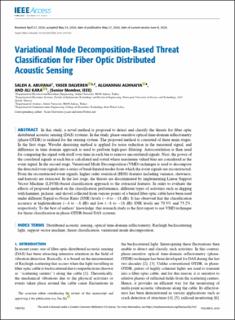| dc.description.abstract | In this study, a novel method is proposed to detect and classify the threats for fiber optic distributed acoustic sensing (DAS) systems. In the study, phase-sensitive optical time-domain reflectometry (phase-OTDR) is realized for the sensing system. The proposed method is consisted of three main stages. In the first stage, Wavelet denoising method is applied for noise reduction in the measured signal, and difference in time domain approach is used to perform high-pass filtering. Autocorrelation is then used for comparing the signal with itself over time in each bin to remove uncorrelated signals. Next, the power of the correlated signals at each bin is calculated and sorted where maximum valued bins are considered as the event signal. In the second stage, Variational Mode Decomposition (VMD) technique is used to decompose the detected event signals into a series of band-limited modes from which the event signals are reconstructed. From the reconstructed event signals, higher order statistical (HOS) features including variance, skewness, and kurtosis are extracted. In the last stage, the threats are discriminated by implementing Linear Support Vector Machine (LSVM)-based classification approach to the extracted features. In order to evaluate the effects of proposed method on the classification performance, different types of activities such as digging with hammer, pickaxe, and shovel collected from various points of a buried fiber optic cable have been used under different Signal-to-Noise Ratio (SNR) levels (-4 to -18 dB). It has observed that the classification accuracy at high/moderate (-4 to -8 dB) and low (-8 to -18 dB) SNR levels are 79.5% and 75.2%, respectively. To the best of authors' knowledge, this research study is the first report to use VMD technique for threat classification in phase-OTDR-based DAS systems. | en_US |

